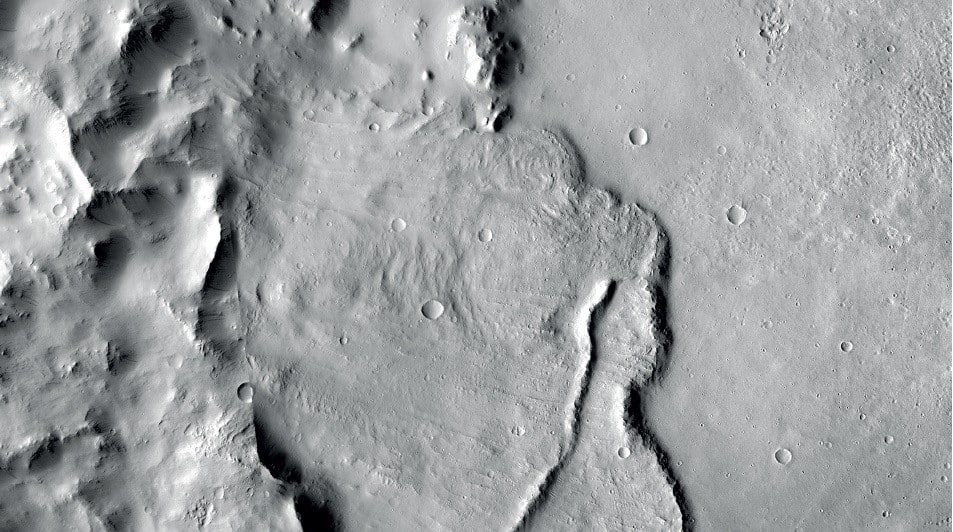
For a long time, scientists have suspected an existence of water and perhaps even life on ancient Mars; especially, since ESA‘s Mars Express discovered a lake below the planet’s South Pole last year. It is still unclear whether there really was any kind of life, but Mars Express has now revealed the first geological evidence that there were indeed large water reservoirs on the Red Planet. Launched on June 2, 2003, the Mars probe reached the planet on December 25, 2003, and has now found a system of ancient interconnected lakes that once lay deep beneath the surface. Five of which may contain minerals crucial to life. Five of these lakes may contain minerals that are crucial to life.
From time immemorial, Mars appears to be an arid world hostile to life, but there are compelling signs on the surface that large amounts of water once existed across the planet. A new study now reveals the extent of underground water on ancient Mars that was previously only predicted by models.

Large water resources
“Early Mars was a watery world, but as the planet’s climate changed this water retreated below the surface to form pools and ‘groundwater’,” says Francesco Salese of Utrecht University, lead author of the study published in the Journal of Geophysical Research – Planets. “We traced this water in our study, as its scale and role is a matter of debate, and we found the first geological evidence of a planet-wide groundwater system on Mars.”
Salese and colleagues explored 24 deep, enclosed craters in the northern hemisphere of Mars, with floors lying roughly 4000 m below Martian “sea level”. Since there are no oceans, the sea level is defined arbitrarily based only on elevation and atmospheric pressure.
Features on the floors of these craters were found that could only have formed in the presence of water. Many craters contain multiple features, all at depths of 4,000 to 4,500 meters – indicating that these craters once contained pools and flows of water that changed and receded over time.

Evidence of rivers and a Martian ocean
There are canals etched into crater walls, valleys carved out by sapping groundwater, dark, curved deltas thought to have formed as water levels rose and fell, ridged terraces within crater walls formed by standing water, and fan-shaped deposits of sediment associated with flowing water. The water level corresponds with the estimated coastlines of a presumed Martian ocean thought to have existed on Mars until three and four billion years ago.
“We think that this ocean may have connected to a system of underground lakes that spread across the entire planet,” says Gian Gabriele Ori, co-author of the study and director of the International School of Planetary Sciences at the Università D’Annunzio in Pescara, Italy. “These lakes would have existed around 3.5 billion years ago, so may have been contemporaries of a Martian ocean.”
In five of the craters, the team also discovered signs of minerals that are linked to the emergence of life on Earth: various clays, carbonates, and silicates. All these findings suggest that these water basins on Mars indeed had everything to host life. Moreover, they were the only basins deep enough to intersect with the water-saturated part of Mars’ crust for long periods of time. Evidence of this may still be buried in the sediments today.

Exo Mars
Further research of these sites may even reveal that there were indeed suitable conditions for the existence of life on Mars. This would also be of great importance for astrobiological missions such as ExoMars – a joint ESA and Roscosmos endeavor. The ExoMars Trace Gas Orbiter has been studying Mars from above for some time, and a new mission is scheduled to start next year.
It comprises a rover – recently named after Rosalind Franklin – and a surface science platform. It will study Martian sites thought to be the most likely ones to have signs of life on Mars.
“Findings like this are hugely important; they help us to identify the regions of Mars that are the most promising for finding signs of past life,” says Dmitri Titov, ESA’s Mars Express project scientist. “It is especially exciting that a mission that has been so fruitful at the Red Planet, Mars Express, is now instrumental in helping future missions such as ExoMars explore the planet in a different way. It’s a great example of missions working together with great success.”
You might also like:
ESO’s VLT Shows Bubbles of Brand New Stars
Hubble discovers the brightest quasar in the early universe
Einstein’s general theory of relativity successfully tested by ESO
Hubble finds more evidence for moon outside our solar system








